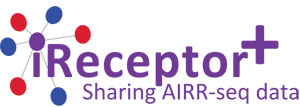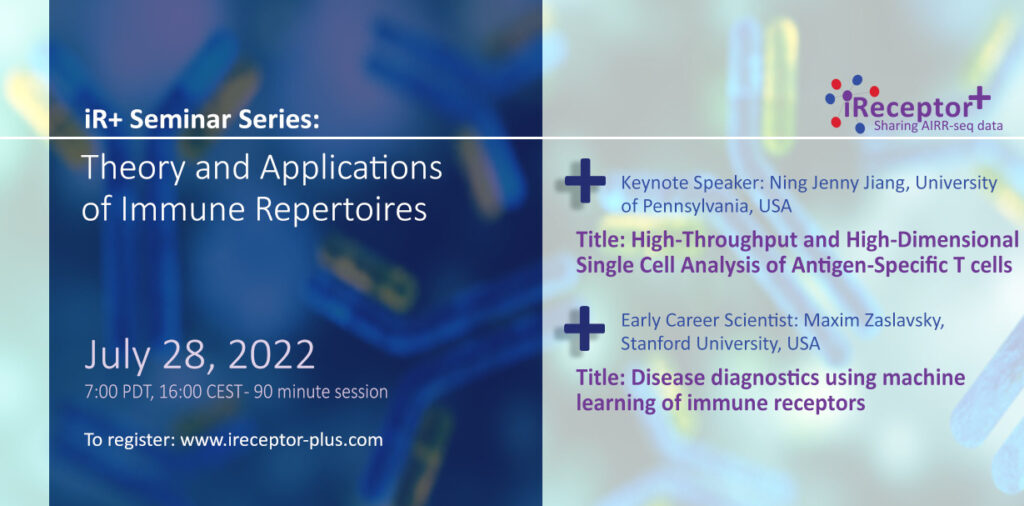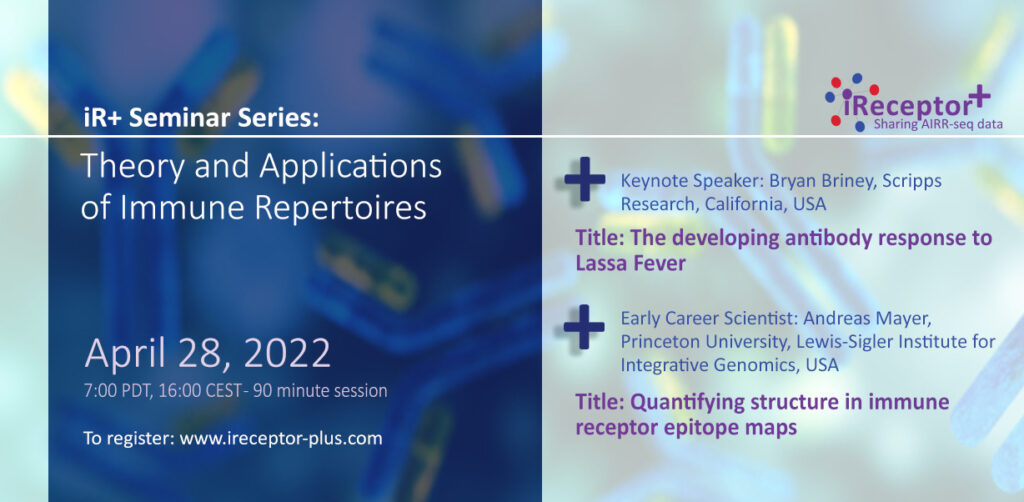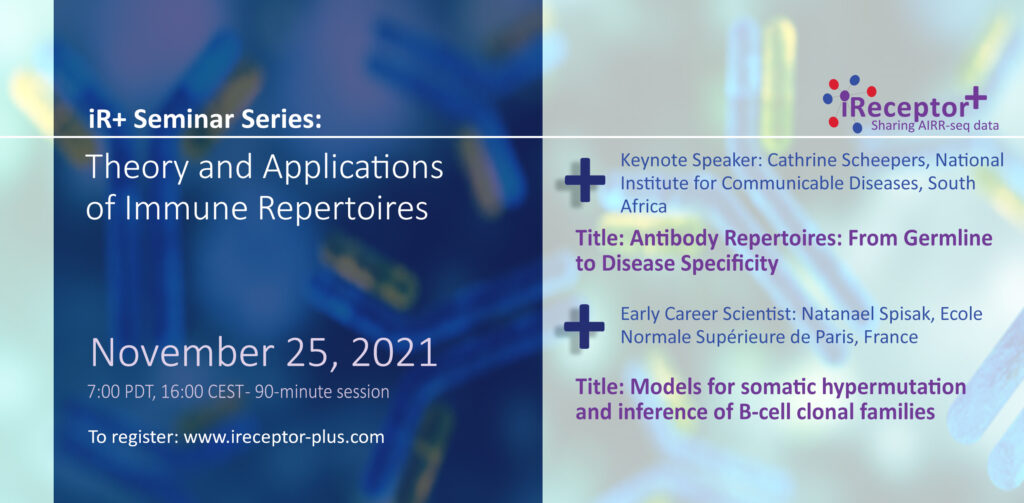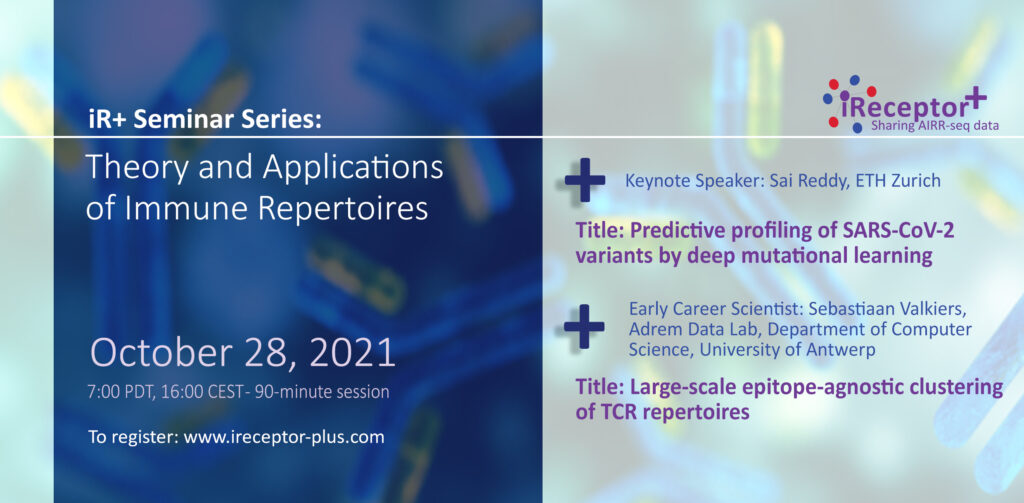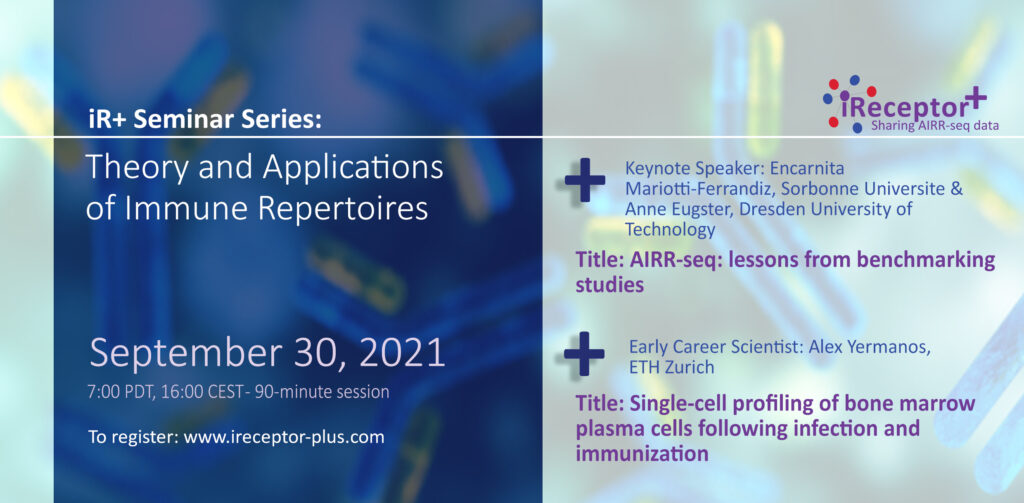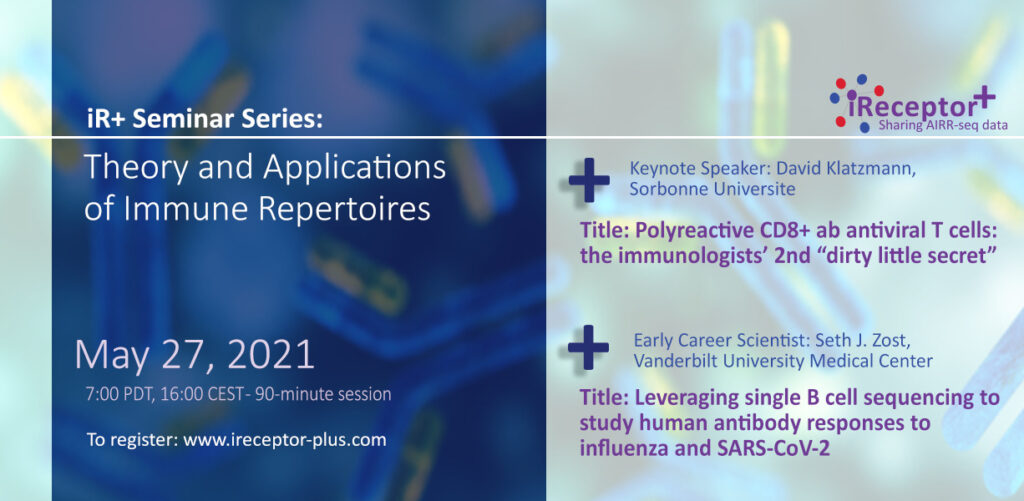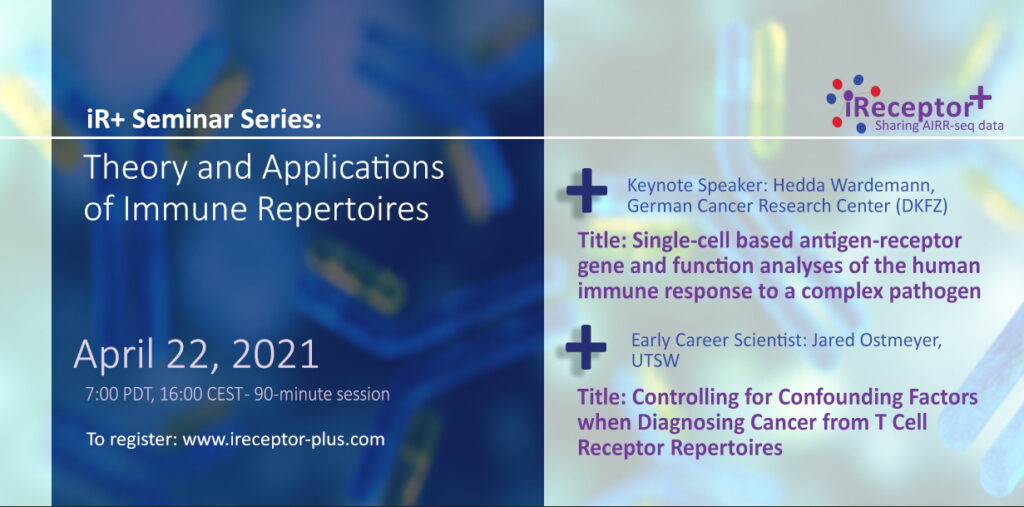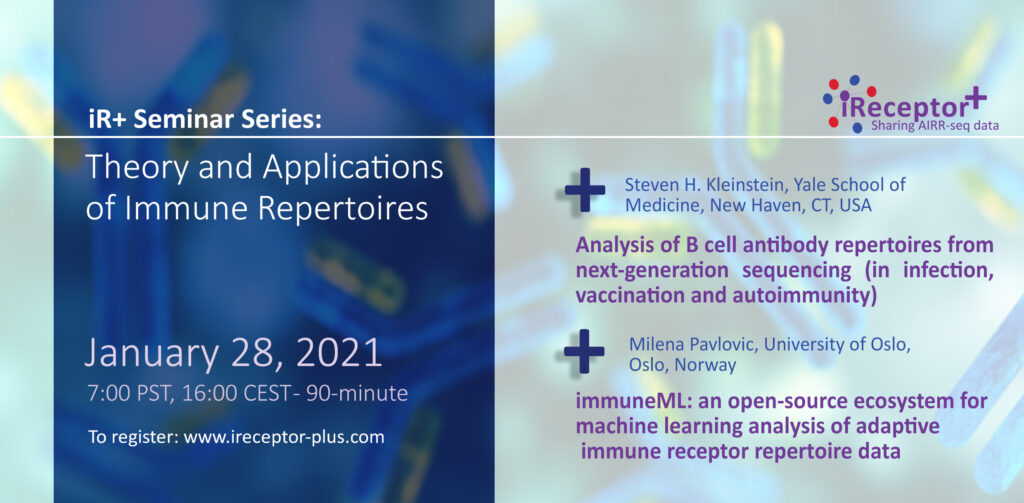iR+ Seminar Series: Theory and Applications of Immune Repertoires
The iReceptor Plus Seminar Series highlights the Theory and Applications of immune repertoires. The overall goal of the iReceptor Plus Consortium is to facilitate sharing and analysis of Adaptive Immune Receptor Repertoire Data. These immune repertoires are rapidly increasing in size and importance to all aspects of immunotherapy, and the Consortium is dedicated to improving analysis and curation tools that will allow the entire immunology community to maximize the benefit of these data for biomedical research and patient care. In the seminar series we will invite one senior and one early career scientist each month to present their most exciting and impactful research in this area.
Zoom connection details will be sent to registrants two days before each seminar.
Seminar series talks are recorded at the discretion of the presenter.
Seminars
iR+ Seminar Series - November 24, 2022
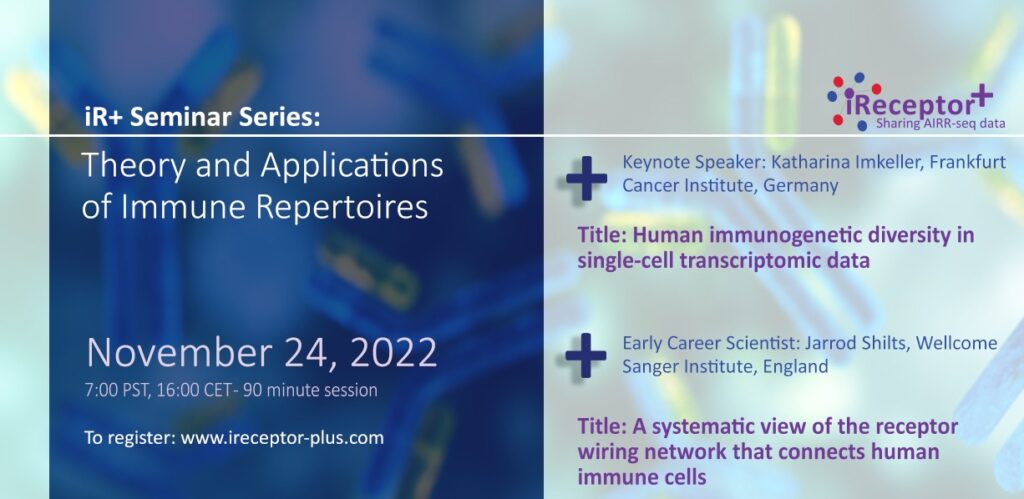
Keynote Speaker: Katharina Imkeller, Frankfurt Cancer Institute, Germany
Title: Human immunogenetic diversity in single-cell transcriptomic data
Abstract: Immune molecules such as B and T cell receptors, human leukocyte antigens (HLAs) and killer Ig-like receptors (KIRs) are encoded in the most diverse genetic loci in the human genome. Many of these immune genes are hyperpolymorphic, showing high allelic diversity across human populations. In addition, typical immune molecules are polygenic, which means that multiple functionally similar genes encode the same protein subunit.
In my talk I will discuss how this affects common bioinformatic approaches for single-cell data analysis and leads to erroneous quantification of important immune mediators and impaired inter-donor comparability.
Early Career Scientist: Jarrod Shilts, Wellcome Sanger Institute, England
Title: A systematic view of the receptor wiring network that connects human immune cells
Abstract: Immune cells are coated in hundreds of different surface proteins. Some of these proteins act as receptors, binding on to proteins from other cells to mediate cell-to-cell communication and direct adhesion. The identification of these receptors can open up new avenues for therapeutically modulating the immune system. Yet despite their significance, we have only had a fragmented picture of the full network of receptor interactions that link human immune cells together.
To resolve this fundamental gap, we have systematically measured which surface proteins engage in receptor interactions and characterized their functions. We devised a high-throughput screening method that is able to measure physical binding interactions at scales approaching a majority of the cell surface proteins detectable on human leukocytes, and then integrated these discoveries with quantitative expression data and versatile cell-based functional assays in order to provide a detailed picture of the dynamic connections that physically connect immune cells.
This work has uncovered direct insights into new molecular mechanisms by which immune cells can interact and communicate, as well as lays a foundation for future systems biology that takes advantage of this more complete view of how the individual cells of the human immune system interact to form a cohesive whole.
iR+ Seminar Series - October 27, 2022
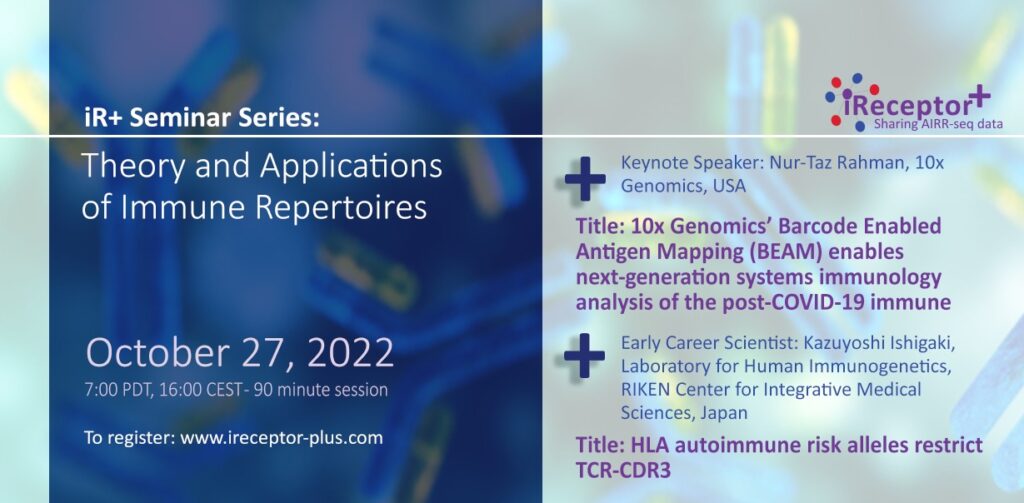
Keynote Speaker: Nur-Taz Rahman, 10x Genomics, USA
Title: 10x Genomics’ Barcode Enabled Antigen Mapping (BEAM) enables next-generation systems immunology analysis of the post-COVID-19 immune landscape
Abstract: A more complete understanding of immune responses to disease requires consideration of multiple different cell types across both the innate and adaptive branches of the immune system, along with the detection of many different analytes.
We used 10x Genomics’ existing Immune Profiling and upcoming Barcode Enabled Antigen Mapping (BEAM) technologies to perform simultaneous multimodal profiling, at single cell resolution. Our sample is thousands of peripheral blood mononuclear cells (PBMCs) from a human donor following recovery from COVID-19. In addition to measuring gene and protein expression, we generated full-length, paired sequences of the rearranged T- and B-cell receptors, while also screening their specificity for a wide range of antigens from SARS-CoV-2 and other viral pathogens.
These data provide insights into the entirety of the immune landscape after recovery from acute viral diseases. The scale and throughput of our experiments gave us high-resolution data from all cell types from the innate and adaptive immune systems. We identified antigen-specific clones of both B and T lymphocytes, with the high cellular throughput enabling detection of rare clones. Analysis of all PBMC cell types allowed us to place these antigen-specific clones within the overall transcriptional landscape of the post-viral immune system.
We are excited that 10x Genomics’ Immune Profiling and BEAM technology will enable the scientific community to perform similar experiments, thus revealing the complex interplay between the components of the immune system, at single-cell resolution. These methods will be extremely valuable in the analysis of the immune response to vaccination, infectious disease, cancer, allergy, autoimmune conditions, and aging that can potentially lead to the development of novel diagnostic and therapeutic approaches.
Early Career Scientist: Kazuyoshi Ishigaki, Laboratory for Human Immunogenetics, RIKEN Center for Integrative Medical Sciences, Japan
Title: HLA autoimmune risk alleles restrict TCR-CDR3
Abstract: Polymorphisms in the human leukocyte antigen (HLA) genes within the major histocompatibility complex (MHC) locus strongly influence autoimmune disease risk. Here, we investigated the influence of HLA alleles on TCR-CDR3. We demonstrated unexpectedly powerful HLA-CDR3 associations.
The strongest association was found at HLA-DRB1 amino acid position 13. This HLA position mediates genetic risk for multiple autoimmune diseases. We identified multiple CDR3 amino acid features enriched by HLA risk alleles and the CDR3 features favored by HLA risk alleles are more enriched among candidate pathogenic TCRs than control TCRs.
iR+ Seminar Series - September 22, 2022
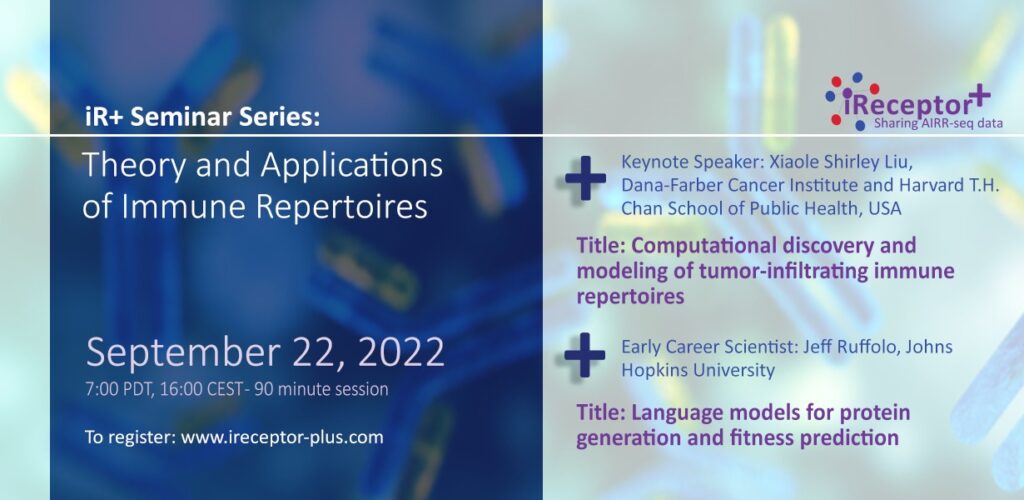
Keynote Speaker: Xiaole Shirley Liu, Dana-Farber Cancer Institute and Harvard T.H. Chan School of Public Health, USA
Title: Computational discovery and modeling of tumor-infiltrating immune repertoires
Abstract: Tumor-infiltrating T cells and B cells are important components in the microenvironment with potential anti-tumor effects. We developed an open-source computational algorithm TRUST (now version 4) to extract the T-cell and B-cell receptor sequences from bulk tumor RNA-seq data as well as 5′ scRNA-seq data without specific V(D)J enrichment. Through analysis of TCGA and immunotherapy cohorts, we observed interesting associations of immune receptor repertoires with age, mutation burdens, immune signaling, and patient outcomes. We created a web server VisualizirR for users to interactively explore these data. Finally, using AI modeling on tumor-infiltrating immune repertoire data, we can potentially develop therapeutic antibodies for cancer treatment.
Early Career Scientist: Jeff Ruffolo, Johns Hopkins University, USA
Title: Language models for protein generation and fitness prediction
Abstract: Language models trained on protein sequences have proven useful for learning representations, predicting three-dimensional structures, and generating novel sequences. This talk will explore the capacity of generative language models for protein sequence generation and fitness predictions. We demonstrate generation of protein sequences adopting diverse folds. Additionally, we investigate the impacts of model scale on a broad set of fitness prediction tasks (including antibody-specific tasks). Finally, we present an antibody-specific infilling language model for generation of natural antibody libraries.
iR+ Seminar Series - July 28, 2022
Keynote Speaker: Ning Jenny Jiang, University of Pennsylvania, USA
Title: High-Throughput and High-Dimensional Single Cell Analysis of Antigen-Specific T cells
Abstract: T cells are important to the initiation, prevention, and cure of many diseases. In the past several years, we have developed several tools to profile the T cell repertoire from T cell receptor diversity to T cell receptor affinity to multi-dimensional profiling of single T cells in high-throughput. In this talk, I will first introduce these tools and then give examples on how we use them to answer some of the fundamental questions in systems immunology, which in turn help us design new approaches in immune engineering.
Early Career Scientist: Maxim Zaslavsky, Stanford University, USA
Title: Disease diagnostics using machine learning of immune receptors
Abstract: Clinical diagnoses rely on a wide variety of laboratory tests and imaging studies, interpreted alongside physical examination and documentation of symptoms and patient history. However, the tools of diagnosis make little use of the immune system’s internal record of specific disease exposures encoded by the antigen-specific receptors of memory B cells and T cells. We combined extensive receptor sequence datasets with three different machine learning representations of immune repertoires to develop an interpretive framework, MAchine Learning for Immunological Diagnosis (Mal-ID), that screens for multiple illnesses simultaneously.
This approach can distinguish specific acute or chronic infections and autoimmune or immunodeficiency disorders. The receptor sequences that Mal-ID prioritizes for disease classification match known immune response patterns for specific viruses like SARS-CoV-2 and HIV. The model also reveals features shared across autoreactive immune responses, demonstrating how machine learning on immune repertoires can yield new immunological knowledge.
iR+ Seminar Series - April 28, 2022
Keynote Speaker: Bryan Briney, Scripps Research, California, USA
Title: The developing antibody response to Lassa Fever
Abstract: Isolation of large numbers of antigen-specific B cells is necessary for the discovery of effective therapeutics, identifying templates to guide rational vaccine design, and development of predictive models of humoral immunity. We have developed a streamlined, generalizable approach for creating DNA-barcoded antigens as well as an integrated informatics pipeline for analyzing and visualizing B cell multi-omics data. We demonstrated the power of this approach by isolating over 1,000 antigen-specific B cells from a small cohort of Lassa Fever survivors, which represent nearly 10-fold more Lassa-specific mAbs than have been reported to date.
Early Career Scientist: Andreas Mayer, Princeton University, Lewis-Sigler Institute for Integrative Genomics, USA
Title: Quantifying structure in immune receptor epitope maps
Abstract: Adaptive immunity is driven by specific binding of hyper-variable receptors to diverse molecular targets. The many-to-many mapping between receptors and their epitope targets determines how the immune system senses threats, but an understanding of its global structure has remained elusive.
In my talk I will introduce an analytical framework to quantify structure in recent high-throughput measurements of such maps. I will discuss how a combination of ideas from population genetics, molecular biophysics, and machine learning is enabling us decipher the probabilistic rules of the degenerate molecular binding code of the immune system.
iR+ Seminar Series - March 24, 2022
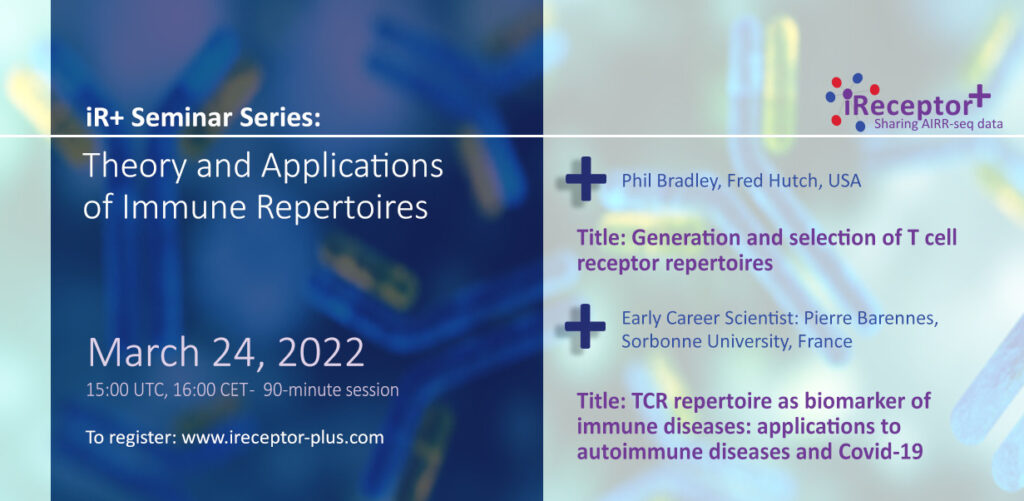
Keynote Speaker: Phil Bradley, Fred Hutch, USA
Title: Generation and selection of T cell receptor repertoires
Abstract: Adaptive immunity relies on diverse repertoires of T and B cell receptors. In this talk, I will describe two ongoing projects aimed at understanding the generation and selection of T cell receptors (TCRs).
In the first project, we have identified common genetic variants that influence the V(D)J recombination process. In the second, we are leveraging large, single-cell datasets to map the phenotypic landscape of TCR sequence convergence across individuals. Joint work with Erick Matsen (Fred Hutch) and Paul Thomas (St. Jude).
Early Career Scientist: Pierre Barennes, Sorbonne University, France
Title: TCR repertoire as biomarker of immune diseases: applications to autoimmune diseases and Covid-19
Abstract: The TCR repertoire constitutes a complex biological component of the immune system that reflects the immune history of each individual. This property is of particular interest for most of the immune pathologies, and in particular for those for which T-cells play a major role.
We are particularly interested in autoimmune diseases (AIDs), for which diagnostic and/or prognostic tools remain limited, as well as in COVID-19, as an example of an emerging infectious disease characterized by a high mortality that has recently affected the world population. Moreover, while most of the TCR repertoire studies analyse total blood repertoire, we focused on T-cell subsets, with various functional properties. In particular, we are interested in deciphering the role and repertoire diversity of effector CD4 T-cells (Teff), as major player in the orchestration of the immune response, as well as on regulatory CD4 T-cells (Treg), involved in the maintenance of the immune homeostasis. A defect of the latter is notably highly associated with autoimmune disorders.
We therefore aimed at identifying TCR signatures of Teffs and Tregs as marker of immune-related diseases and to characterize their convergence and/or dissimilarities between diseases as well as their putative specificities.
iR+ Seminar Series - February 24, 2022
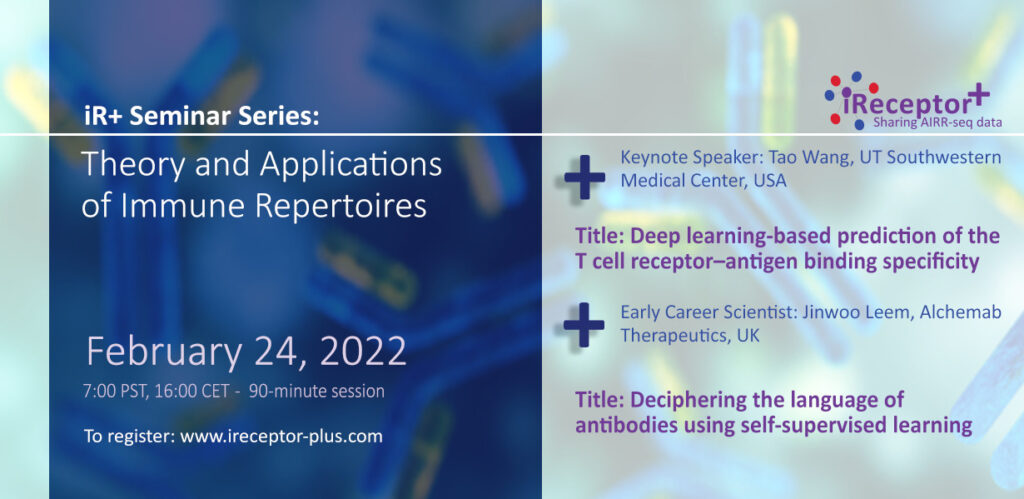
Keynote Speaker: Tao Wang, UT Southwestern Medical Center, USA
Title: Deep learning-based prediction of the T cell receptor–antigen binding specificity
Abstract: Neoantigens play a key role in the recognition of tumour cells by T cells; however, only a small proportion of neoantigens truly elicit T-cell responses, and few clues exist as to which neoantigens are recognized by which T-cell receptors (TCRs).
We built a transfer learning-based model named the pMHC–TCR binding prediction network (pMTnet) to predict TCR binding specificities of the neoantigens—and T cell antigens in general—presented by class I major histocompatibility complexes. pMTnet was comprehensively validated by a series of analyses and exhibited great advances over previous works.
By applying pMTnet to human tumour genomics data, we discovered that neoantigens were generally more immunogenic than self-antigens, but human endogenous retrovirus E (a special type of self-antigen that is reactivated in kidney cancer) is more immunogenic than neoantigens.
We further discovered that patients with more clonally expanded T cells that exhibit better affinity against truncal rather than subclonal neoantigens had more favourable prognosis and treatment response to immunotherapy in melanoma and lung cancer but not in kidney cancer.
Predicting TCR–neoantigen/antigen pairing is one of the most daunting challenges in modern immunology; however, we achieved an accurate prediction of the pairing using only the TCR sequence (CDR3β), antigen sequence and class I major histocompatibility complex allele, and our work revealed unique insights into the interactions between TCRs and major histocompatibility complexes in human tumours, using pMTnet as a discovery tool.
Early Career Scientist: Jinwoo Leem, Alchemab Therapeutics, UK
Title: Deciphering the language of antibodies using self-supervised learning
Abstract: An individual’s B cell receptor (BCR) repertoire encodes information about past immune responses, and potential for future disease protection.
Deciphering the information stored in BCR sequence datasets will transform our fundamental understanding of disease and enable discovery of novel diagnostics and antibody therapeutics.
One of the grand challenges of BCR sequence analysis is the prediction of BCR properties from their amino acid sequence alone. Here we present an antibody-specific language model, AntiBERTa, which provides a contextualised representation of BCR sequences.
Following pre-training, we show that AntiBERTa embeddings learn biologically relevant information, generalizable to a range of applications. As a case study, we demonstrate how AntiBERTa can be fine-tuned to predict paratope positions from an antibody sequence, outperforming public tools across multiple metrics.
To our knowledge, AntiBERTa is the deepest protein family-specific language model, providing a rich representation of BCRs. AntiBERTa embeddings are primed for multiple downstream tasks and can improve our understanding of the language of antibodies.
iR+ Seminar Series - January 27, 2022
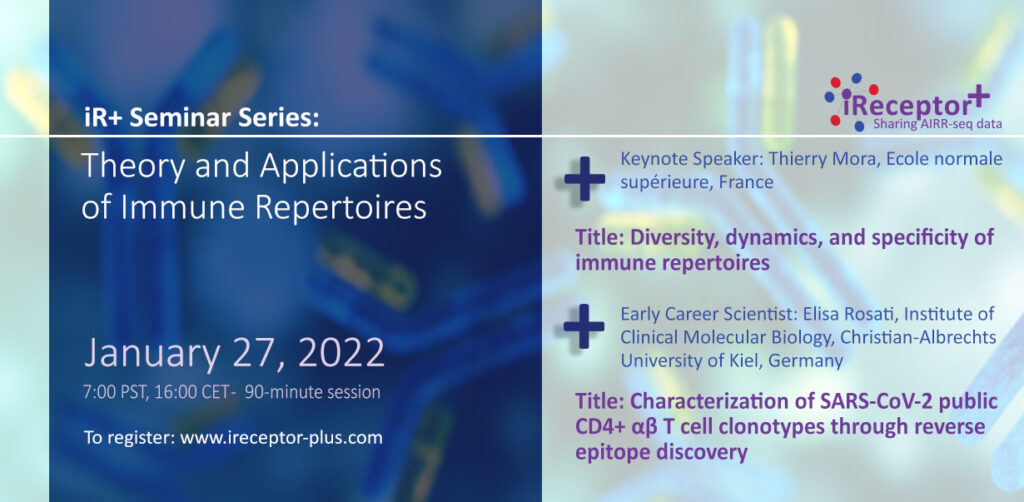
Keynote Speaker: Thierry Mora, Ecole normale supérieure, France
Title: Diversity, dynamics, and specificity of immune repertoires
Abstract: To recognize any potential threat, the adaptive immune system is endowed with a wide variety of B and T cell receptors created by VDJ recombination. I will show how the rules of diversity generation can be learned from high-throughput sequencing data to create generative models of receptor abundance.
The models predict repertoire overlap between healthy individuals, capture statistical differences between cell types, and can be used to detect anomalies caused by a common health condition, including infections. In the second part, I will present a probabilistic treatment of longitudinal sequencing data to understand the clonal dynamics of immune repertoires in healthy individuals over years, and during acute infections over days and weeks. I will show how to leverage these methods to identify pathogen-specific receptors.
Early Career Scientist: Elisa Rosati, Institute of Clinical Molecular Biology, Christian-Albrechts University of Kiel, Germany
Title: Characterization of SARS-CoV-2 public CD4+ αβ T cell clonotypes through reverse epitope discovery
Abstract: The amount of scientific data and level of public sharing produced as a consequence of the COVID-19 pandemic, as well as the speed at which these data were produced, far exceeds any previous effort against a specific disease condition.
This unprecedented situation allows for development and application of new research approaches. One of the major technical hurdles in immunology is the characterization of HLA-antigen-T cell receptor (TCR) specificities. Most approaches aim to identify reactive T cells starting from known antigens using functional assays. However, the need for a reverse approach identifying the antigen specificity of orphan TCRs is increasing. Utilizing large public single-cell gene expression and TCR datasets, we identified highly public CD4+ T cell responses to SARS-CoV-2, covering >75% of the analysed population.
We performed an integrative meta-analysis to deeply characterize these clonotypes by TCR sequence, gene expression, HLA-restriction, and antigen-specificity, identifying strong and public CD4+ immunodominant responses with confirmed specificity. CD4+ COVID-enriched clonotypes show T follicular helper functional features, while clonotypes depleted in SARS-CoV-2 individuals preferentially had a central memory phenotype. In total we identify more than 1200 highly public CD4+ T cell clonotypes reactive to SARS-CoV-2.
TCR similarity analysis showed six prominent TCR clusters, for which we predicted both HLA-restriction and cognate SARS-CoV-2 immunodominant epitopes. To validate our predictions we used an independent cohort of TCR repertoires before and after vaccination with ChAdOx1, a replication-deficient simian adenovirus-vectored vaccine, encoding the SARS-CoV-2 spike protein. We find statistically significant enrichment of the predicted spike-reactive TCRs after vaccination with ChAdOx1, while the frequency of TCRs specific to other SARS-CoV-2 proteins remains stable. Thus, the CD4-associated TCR repertoire differentiates vaccination from natural infection.
In conclusion, our study presents a novel reverse epitope discovery approach that can be used to infer HLA- and antigen-specificity of orphan TCRs in any context, such as viral infections, antitumor immune responses, or autoimmune disease.
Keynote Speaker: Cathrine Scheepers, National Institute for Communicable Diseases, South Africa
Title: Antibody Repertoires: From Germline to Disease Specificity
Abstract: The vast antibody repertoire, essential in the adaptive immune response to many pathogens, is predetermined by one’s germline antibody repertoire. Though the human germline repertoire is fairly well characterized, ongoing research on human antibody genes continues to highlight differences not only at the allelic level but also whole gene copy number variation.
We have studied germline antibody genes of South African individuals and highlighted the genetic and structural differences in these compared to other ethnicities. In addition, we have studied the rearranged antibody repertoires in response to HIV. Antibody lineage-HIV co-evolutionary studies have provided a mechanism for how immune responses drive viral escape mutants, which in turn shape antibody maturation.
Many of the rearranged antibody repertoire studies we have conducted have been on donors for which we have matched germline repertoires. One of our current aims is to determine the level at which the germline repertoire predetermines the rearranged repertoire. In addition, we are in the process of curating all of our antibody repertoire studies using MiAIRR complaint standards and will soon launch our own repository, within iReceptor Plus, making these repertoires available for cross-study comparisons. The power of this public repository is the ability to identify public clonotypes enabling a greater understanding of disease specific responses.
Early Career Scientist: Natanael Spisak, Ecole Normale Supérieure de Paris, France
Title: Models for somatic hypermutation and inference of B-cell clonal families
Abstract: Somatic hypermutations drive B-cell receptors’ ability to evolve strong affinity to their antigenic targets. The landscape of these mutations is highly heterogeneous, with certain regions of the Ig gene being preferentially targeted. We propose a model that accounts for phylogenetic correlations between sequences and the interference of selective forces to predict mutation profiles.
The model reveals that both the sequence context of the mutation and its absolute position along the gene are important. We also find that substitutions occurring concomitantly along B-cell lineages tend to co-localize, suggesting a possible mechanism for accelerating affinity maturation.
Equipped with a probabilistic description of VDJ recombination and somatic hypermutations, we revisit the task of identifying lineages in B cell repertoire data. The models help us to disentangle genetic relationships from the effects of convergent recombination and parallel mutations. We show that a likelihood-based approach improves precision as well as extends the range of sensitivity of clonal families inference. Thanks to a high-fidelity partition, we can characterize the inter- and intra-lineage diversity of the repertoire.
Keynote Speaker: Sai Reddy, ETH Zurich
Title: Predictive profiling of SARS-CoV-2 variants by deep mutational learning
Abstract: The continual evolution of the severe acute respiratory syndrome coronavirus-2 (SARS-CoV-2) and the emergence of variants that show resistance to vaccines and neutralizing antibodies threatens to prolong the coronavirus disease 2019 (COVID-19) pandemic.
Selection and emergence of SARS-CoV-2 variants are driven in part by mutations within the viral spike protein and in particular, the receptor-binding domain (RBD), which binds to the human ACE2 receptor and is a primary target site for neutralizing antibodies.
Comprehensive mapping of single-position substitutions in the RBD has revealed key mutations that enhance binding to ACE2 and provide an escape from neutralizing antibodies. However, several SARS-CoV-2 variants such as beta (B.1.351) gamma (P.1) and delta (B.1.617.2) possess multiple, combinatorial mutations in their RBD. Here, we develop deep mutational learning (DML) – a machine learning-guided protein engineering technology that enables the comprehensive interrogation of combinatorial mutations in the RBD and prediction of their impact on ACE2 binding and antibody escape.
DML reveals a highly diverse sequence landscape of possible variants that maintain or enhance binding to ACE2 and escape from different classes of neutralizing antibodies. DML may be used in the future to comprehensively profile the breadth of candidate therapeutic antibodies against existing and prospective variants of SARS-CoV-2.
Title: Large-scale epitope-agnostic clustering of TCR repertoires
Abstract: T-cell receptor (TCR) repertoires often accommodate many thousands or even millions of unique sequences. This system is complex and personalized, therefore providing enormous potential for the identification of highly specific biomarkers or therapeutic targets. However, disease-associated immune signatures are rare. One TCR relevant to a certain immune state may be masked by as many as one million irrelevant receptors. Hence, the high-dimensional nature and low signal-to-noise ratio of this system impose difficulty in analysis, requiring careful interpretation of results.
Nonetheless, there exists a certain degree of redundancy in the repertoire, as similar TCR sequences have a tendency to recognize the same epitope. Through similarity-based clustering we can reduce the complexity of TCR sequencing data sets and integrate them to resolve potential disease-related immune signatures. However, highly specific clustering of millions of sequences is not a trivial task that requires knowledge of the distances between any pair of two TCRs in the data set, which is a computationally expensive procedure.
This seminar will focus on those difficulties associated to large-scale TCR repertoire clustering and proposes solutions to address them. Practical considerations will be provided for analyzing clustering results and prioritizing potential disease-associated groups of TCR sequences.
Title: AIRR-seq: lessons from benchmarking studies
Abstract: With the advances in AIRR-seq sequencing and data modelling, T-cell receptor- and B-cell repertoires offer new possibilities in diagnostics, providing biomarkers for monitoring several immune related diseases and tools for the development of new therapeutic targets. In the race of AIRR-seq method development, reliability, reproducibility and sensitivity are central prerequisites to the grasping of this complex biological system characterized by uneven diversity.
During this seminar, Encarnita Mariotti-Ferrandiz will introduce her recent comparative study that evaluated the performances of various molecular biology methods commonly used in the field for T-cell receptor repertoire study. Anne Eugster will then introduce plans from the AIRR-Community Biological Resources Working Group regarding a similar study on B-cell receptor benchmarking.
Early Career Scientist: Alex Yermanos, ETH Zurich
Title: Single-cell profiling of bone marrow plasma cells following infection and immunization
Abstract: Immune repertoires represent a vast and diverse collection of T and B cell receptors which are able to interact with a seemingly infinite number of foreign pathogens. Recent advances in high-throughput sequencing and microfluidics allow us to pair immune receptor sequence and gene expression at the single-cell resolution.
This technology is instrumental both to quantify clonal selection of immune populations and to discover novel lymphocytes relevant in the context of disease, immunization, and infection. Plasma cells and their secreted antibodies play a central role in the long-term protection against pathogens. However, due to experimental limitations, a comprehensive description of linked genotypic, phenotypic, and antibody repertoire features of plasma cells (e.g., gene expression, clonal frequency, specificity) has been challenging to obtain.
To address this, we performed single-cell transcriptome and antibody repertoire sequencing of the murine bone marrow plasma cell population following viral infections and protein-based immunisations. We have furthermore developed an accompanying software package, named Platypus, to both quantify clonal selection within the aforementioned experimental conditions and to integrate public repertoire data.
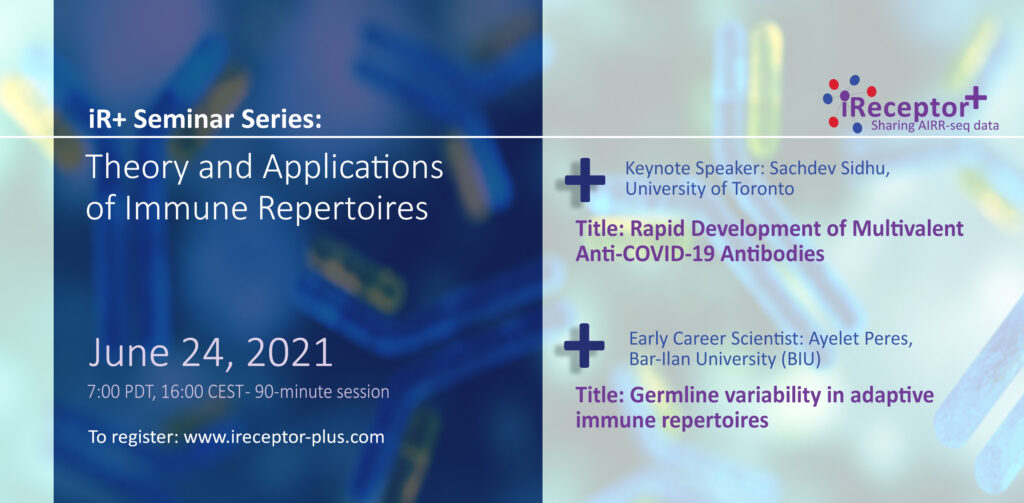
iR+ Seminar Series - June 24, 2021
Keynote Speaker: Sachdev Sidhu, University of Toronto
Title: Rapid Development of Multivalent Anti-COVID-19 Antibodies
Abstract: We used protein engineering to develop tetravalent synthetic neutralizing antibodies for SARS-CoV-2. We show that these antibodies can be produced at large scale and possess stability and specificity comparable to approved antibody drugs. The best antibody targets the host receptor binding site of the virus spike protein, and thus, its tetravalent version can block virus infection with a potency that far exceeds that of the bivalent IgG.
Recombinant neutralizing antibodies (nAbs) derived from recovered patients hold promise as effective therapeutics against COVID-19. Here, we describe the use of advanced protein engineering and modular design principles to develop tetravalent synthetic nAbs that mimic the multi-valency exhibited by IgA molecules, which are especially effective natural inhibitors of viral disease.
At the same time, these nAbs display high affinity and modularity typical of IgG molecules, which are the preferred format for drugs. We show that highly specific tetravalent nAbs can be produced at large scale and possess stability and specificity comparable to approved antibody drugs. Moreover, structural studies reveal that the best nAb targets the host receptor binding site of the virus spike protein, and thus, its tetravalent version can block virus infection with a potency that exceeds that of the bivalent IgG by an order of magnitude.
Design principles defined here can be readily applied to any antibody drug, including IgGs that are showing efficacy in clinical trials. Thus, our results present a general framework to develop potent antiviral therapies against COVID-19, and the strategy can be readily deployed in response to future pathogenic threats.
Early Career Scientist: Ayelet Peres, Bar-Ilan University (BIU)
Title: Germline variability in adaptive immune repertoires
Abstract: Many recent studies utilize adaptive immune receptor repertoire sequencing (AIRR-seq) data to open new prospects in understanding the adaptive immune system. We and others use AIRR-seq data to gain insight on genomic variability within the T and B cell receptor encoding genomic loci.
To this end, we adapted and developed tools for genotype and haplotype inferences from AIRR-seq data. Applying our methods to several public data sets revealed a plethora of novel undocumented TRBV, IGHV, IGKV and IGLV alleles, structural variations, and variations in the untranslated regions including alternative splicing events.
In this talk I will cover our recent work and show how the discovered variations affect the expressed repertoires. I will also discuss challenges with these kinds of inferences, such as indistinguishable sequences coming from different genes and/or partial sequencing protocols, and our current thinking for how to overcome these challenges.
iR+ Seminar Series - May 27, 2021
Keynote Speaker: David Klatzmann, Sorbonne Universite
Title: Polyreactive CD8+ ab antiviral T cells: the immunologists’ 2nd “dirty little secret”
Abstract: How evolution shaped a process that produces TCRs that would effectively respond to diverse infectious agents is a central question of immunology. The paradigm is that a diverse enough repertoire of TCRs should always provide a proper, though rare, specificity for any given need. Expansion of such rare T cells would provide enough fighters for an efficacious immune response and enough antigen-experienced cells for memory.
We found that thymopoiesis releases a large population of CD8+ T cells harboring diverse α/βTCRs that are highly enriched for viral antigen recognition and have a fuzzy rather than tight specificity. In vitro, they bind to and are activated by multiple unrelated viral peptides. In vivo, T cells harboring such TCR respond to vaccination, infection, including COVID-19, and cancer.
Our results support an evolutionary selection of pleiospecific α/βTCRs for broad antiviral responses and heterologous immunity.
Early Career Scientist: Seth J. Zost, PhD, Postdoctoral Fellow, Crowe Laboratory, Vanderbilt Vaccine Center, Vanderbilt University Medical Center
Title: Leveraging single B cell sequencing to study human antibody responses to influenza and SARS-CoV-2
Abstract: Respiratory viruses such as influenza viruses and coronaviruses are major threats to public health, and both of these families of viruses have caused pandemics in the 21st century. In addition, circulation of seasonal influenza viruses results in significant morbidity and mortality.
In the case of both pathogens, antibodies play a major role in protection from infection, but there are important unanswered questions as to which epitopes are targeted in human immune responses, how antibody lineages evolve after repeated exposures, and the degree to which B cell clonotypes are shared between individuals.
Recent advances in single cell sequencing and gene synthesis have enabled paired sequencing of B cell populations and antibody discovery at previously unprecedented scales. Here, I will highlight several examples from our group where we have coupled repertoire sequencing and high-throughput antibody expression to both study the evolution of antibody lineages and to identify public clonotypes in the antibody responses to both influenza and SARS-CoV-2.
iR+ Seminar Series - April 22, 2021
Keynote Speaker: Hedda Wardemann, German Cancer Research Center (Deutsches Krebsforschungszentrum, DKFZ), Heidelberg, Germany
Title: Single-cell based antigen-receptor gene and function analyses of the human immune response to a complex pathogen
Abstract: We have developed a platform for the high-throughput analysis of Ig gene repertoires that preserves natural IgH and IgL gene associations and provides full-length Ig gene sequence information for direct gene cloning and the production of recombinant monoclonal antibodies. Recently, we have established a similar platform for the amplification and cloning of paired T cell receptor (TCR) alpha and beta chain genes to enable functional assessments of TCRs at single cell level. I will discuss how we use this platform to study the clonal evolution and functional quality of the human immune response to the malaria parasite Plasmodium falciparum with the long-term goal to develop improved vaccine design strategies.
Early Career Scientist: Jared Ostmeyer, UTSW
Title: Controlling for Confounding Factors when Diagnosing Cancer from T Cell Receptor Repertoires
Abstract: Our publications have shown that T cell receptor (TCR) repertoires sequenced from tissue biopsies can be used to distinguish tumor from control tissue with > 90% classification accuracies, suggesting that TCR repertoires can be used to diagnose cancer.
TCR repertoires sequenced from blood samples of cancer patients are now publicly available, and it is tempting to use these existing samples to develop blood-based assays for diagnosing cancer. Already, research groups including us have obtained promising results. However, these results are obtained by combining cancer and control samples from mismatching studies. Without controlling for age, sex, race, and even the reduced amount of blood volume collected from cancer patients relative to controls, these exciting results could merely be an artifact of confounding factors.
In this study, we control for possible confounding factors and observe that our ability to diagnose cancer from TCR repertoires sequenced from blood does not vanish. On patient-holdout cross-validations, we achieve diagnostic accuracies of 90% for colorectal cancer (controlling for depth coverage), 84% for breast cancer (controlling for depth coverage and age), and 83% for lung cancer (controlling for age, sex, race, and depth coverage).
While it is impossible to control for all potential confounding factors like variations in geographic locations, these results are encouraging. We propose future studies that (i) collect matching controls and cases and (ii) confirm TCR repertoire sequencing provides a distinct signal for diagnosing cancer independent of other blood-based assays and therefore can improve the diagnostic performance of these other blood-based assays.
iR+ Seminar Series - March 25, 2021
Keynote Speaker: Corey Watson, University of Louisville
Title: Germline polymorphisms in the heavy chain immunoglobulin locus contribute to variation in the antibody repertoire
Abstract: The immunoglobulin loci are among the most complex and polymorphic regions of mammalian genomes. The complexity of these loci has historically hindered our ability to fully characterize the extent of haplotype diversity that exists within and between species, and in turn, delineate the impact of germline variation on antibody-mediated responses.
A major focus of my lab is the development of novel genomic tools that leverage long read sequencing to comprehensively genotype the IG loci. In this talk, I will discuss our ongoing efforts to expand genomic resources for the human IG loci, and present data that demonstrate connections between IG polymorphism and inter-individual variation in the expressed antibody repertoire.
Early Career Scientist: Mamie Wang, (Interdepartmental Program in Computational Biology and Bioinformatics), Yale University
Title: High-throughput Single-cell Profiling of B cell Responses Following Inactivated Influenza Vaccination in Young and Older Adults
Abstract: Seasonal influenza contributes to a substantial disease burden annually, resulting in approximately 10 million hospital visits and 50 thousand deaths in a typical year in the US. 90% of the annual mortality from influenza occurs in people over the age of 65. While influenza vaccination is the best protection against the virus, it is less effective for the elderly. This may be due to differences in the quantity or type of B cells induced by vaccination in older individuals. To investigate this possibility, we leveraged recent development in single-cell technology that allows for simultaneous measurement of both gene expression profile and the B cell receptor (BCR) at single-cell resolution.
Pre- and post-vaccination peripheral blood B cells were sorted from three young and three older adults who responded to the inactivated influenza vaccine and were profiled using single-cell RNAseq with paired BCR sequencing. At pre-vaccination, we observed a higher somatic hypermutation frequency and a higher abundance of activated B cells in older adults than young adults. Following vaccination, young adults mounted a more clonal response than older adults. The response involved a mix of plasmablasts, activated B cells, and resting memory B cells in both age groups. The response in young adults was dominated by expansion in plasmablasts, while older adults’ response also involved activated B cells.
We observed a consistent change in gene expression in plasmablasts after vaccination between age groups but not in the activated B cells. These quantitative and qualitative differences in the B cell response may provide insights into the age-related change of influenza vaccination response.
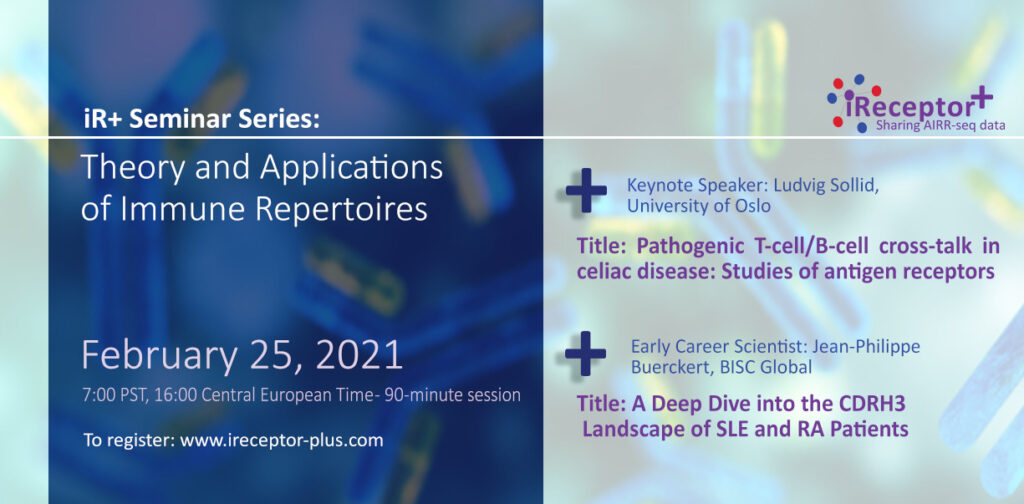
iR+ Seminar Series - February 25, 2021
Keynote Speaker: Ludvig Sollid, University of Oslo
Title: Pathogenic T-cell/B-cell cross-talk in celiac disease: Studies of antigen receptors
Abstract: Adaptive immunity with involvement of antigen-specific T cells and B cells are likely essential in development of autoimmune diseases. Research on the involvement of autoimmune T and B cells is however hampered by the lack of knowledge of the disease driving antigens, particularly in humans. Celiac disease, a common disorder that has autoimmune features and this is caused by a maladapted immune response to cereal gluten proteins, is an exception in this regard. The disease is driven by activation of gluten-reactive CD4+ T cells and it is hallmarked by highly disease specific autoantibodies to the enzyme transglutaminase 2 (TG2) and to deamidated gluten peptides (DGP). I will discuss recent findings on the phenotype of gluten-reactive CD4+ T cells, the usage of disease-relevant T-cell receptors and B-cell receptors as well as the crosstalk between pathogenic T cells and B cells in this instructive human disorder.
Early Career Scientist: Jean-Philippe Buerckert, BISC Global
Title: A Deep Dive into the CDRH3 Landscape of SLE and RA Patients
Abstract: Systemic lupus erythematosus (SLE) and rheumatoid arthritis (RA) are two common polygenic autoimmune diseases characterized by elevated serum autoantibodies against a variety of tissue antigens and progressive damage in multiple organs and tissues. In both diseases, malfunctioning checkpoints result in the loss of self-reactivity control of the adaptive immune receptor repertoires (AIRR) manifesting in the production of autoreactive B-cells.
Here we show how AIRR-seq can be applied to dissect the CDRH3 repertoire from PBMC B-cell isolates. Sampling was performed from 10 SLE and 11 RA patients over two timepoints as well as those of 10 healthy controls yielding a total of about 20,000,000 sequences after filtering.
Globally, our data show increased non-functional BCR rearrangements in both diseases compared to healthy donors. We examined CDRH3 repertoire down to the single amino acid level and found that RA and to a lesser extent SLE patient’s repertoires are characterized by increased amounts of hydrophobic k-mers and amino acids compared to healthy controls.
Collectively, these observations shed new light on the underlying molecular basis of autoreactive B-cells in SLE and RA and indicate a complex cluster of B-cell development defects.
iR+ Seminar Series - January 28, 2021
Keynote Speaker: Steven H. Kleinstein, Yale School of Medicine, New Haven, CT, USA
Title: Analysis of B cell antibody repertoires from next-generation sequencing (in infection, vaccination and autoimmunity)
Abstract: Next-generation sequencing (NGS) technologies have revolutionized our ability to carry out large-scale adaptive immune receptor repertoire sequencing (AIRR-Seq) experiments. AIRR-Seq is increasingly being applied to profile B cell receptor (BCR) repertoires and gain insights into immune responses in healthy individuals and those with a range of diseases. As NGS technologies improve, these experiments are producing ever larger datasets, with tens- to hundreds-of-millions of BCR sequences. Although promising, repertoire-scale data present fundamental challenges for analysis requiring the development of new techniques and the rethinking of existing methods that are not scalable to the large number of sequences being generated [1].
To address these challenges, we have developed computational tools and methods that we currently make available to the wider scientific community through the Immcantation tool suite. This includes: raw read processing, novel V gene allele detection, subject-specific germline genotype identification, B cell clone assignment, lineage tree construction and analysis, somatic mutation profiling and selection analysis. Along with the underlying computational methodology, this presentation will discuss applications of BCR repertoire sequencing and lineage analysis to infection (Lyme disease, COVID-19 and West Nile Virus), vaccination (Influenza), autoimmunity (Multiple sclerosis, Myasthenia Gravis) and allergy/asthma.
- Yaari G, Kleinstein SH. Practical guidelines for B-cell receptor repertoire sequencing analysis. Genome Med. 2015 Nov 20;7:121. doi: 10.1186/s13073-015-0243-2.
Early Career Scientist: Milena Pavlovic, University of Oslo, Oslo, Norway
Title: immuneML: an open-source ecosystem for machine learning analysis of adaptive immune receptor repertoire data
Abstract: Adaptive immune receptor repertoires (AIRR) are key targets for immunological and pharmacological research as they provide a DNA-sequence record of all past and ongoing adaptive immune responses in health, disease, infection and vaccination. The capacity of machine learning (ML) to learn complex discriminative sequence patterns has led to its increasing use for AIRR-based diagnostics and therapeutics discovery. Previous developments have however been highly heterogeneous in terms of technical solutions, domain assumptions and user-interaction options, hampering transparent comparative evaluation and the ability to explore and select ML methodology most appropriate for a given study.
immuneML addresses these previous concerns by covering all major steps in AIRR ML within an open-source ecosystem and online user interface: AIRR sequence data read-in and encoding, training ML models of antigen specificity or immune state prediction as well as model assessment and interpretation. We demonstrate the broad applicability of immuneML for AIRR ML research by (i) replicating inside immuneML a published large-scale study on AIRR-based immune state prediction, (ii) applying a novel ML method for AIRR-based antigen specificity prediction and (iii) showcasing how immuneML may be used for AIRR ML method benchmarking. immuneML promotes reproducibility, customizability and shareability by (i) providing infrastructure for sharing complete ML workflows and intermediate steps, (ii) useful default parameters and workflows that shield beginners from common ML mistakes, (iii) and a user-friendly design based on the Galaxy framework.
Lab website: Sandve Lab, Greiff Lab
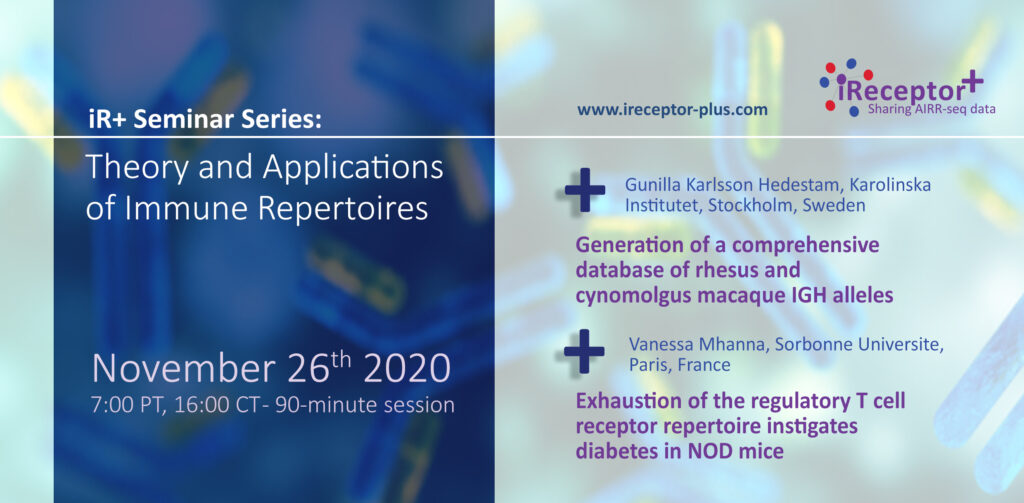
iR+ Seminar Series - November 26, 2020
Keynote: Gunilla Karlsson Hedestam, Karolinska Institutet, Stockholm, Sweden
Title: Generation of a comprehensive database of rhesus and cynomolgus macaque IGH alleles
Abstract: We applied the immunoglobulin (IG) gene inference tool, IgDiscover, to define germline VDJ alleles in 45 macaques of different origins. Our analysis resulted in a comprehensive database comprising 1198 IGHV alleles, of which around 70% were not previously described. Haplotype analysis of the animals revealed a considerable level of structural variation in the IGH locus. This work will facilitate high-quality B cell studies in rhesus and cynomolgus macaques.
Early Career Scientist: Vanessa Mhanna, Sorbonne Universite, Paris, France
Title: Exhaustion of the regulatory T cell receptor repertoire instigates diabetes in NOD mice
Abstract: Non-obese diabetic (NOD) mice spontaneously develop autoimmune diabetes. We aimed to analyze their TCR repertoire to better understand NOD autoimmunity. We performed next-generation sequencing of TCRs from splenocytes of prediabetic NOD and normal B6 mice. We analyzed the repertoire of CD4+ effector T cells (Teffs), CD44low CD62Lhigh naïve regulatory T cells (nTregs) and CD44high CD62Llow activated/memory Tregs (amTregs). These latter are known to respond to self-antigens and to be involved in protection against autoimmune diseases.
NOD and B6 nTreg TCR β repertoires were very diverse and mostly composed of unexpanded clonotypes. In contrast, B6 amTregs contained frequent expanded clonotypes that were lost in NOD amTregs resulting in an increased diversity of their repertoire. This was also seen, albeit to a lesser extent, in NOD Teffs. These observations suggested that NOD mice had lost the amTreg clonotypes that could protect them from diabetes.
As IL-2 administration leads to Tregs expansion and activation, and correlatively to protection from diabetes occurrence, we investigated the effects of IL-2 on NOD TCR repertoires. IL-2 administration to NOD mice restored amTreg clonotype expansions and led to few and no clonotype expansions of nTreg and Teffs, respectively. Noteworthily, IL-2-expanded amTreg and nTreg clonotypes were markedly enriched for islet-antigen specific TCRs.
Altogether, our results establish a causal link between an IL-2-mediated impoverishment of Treg repertoires affecting self‑antigen-specific TCRs and the development of autoimmune disease.
